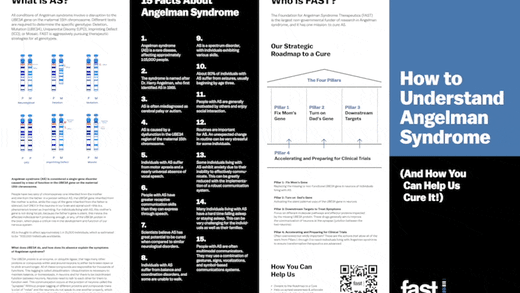Families & Caregivers
Treatment & Trials
When it comes to developing new treatments for rare diseases, it can feel like we are playing a game of chutes and ladders, but in real life. It’s a game filled with dreamed-for progress and heartbreaking setbacks, and it tests the patience and bravery of our community all the time.
FAST manages our Roadmap to a Cure to find a way to bring a promising therapeutic to your loved one as safely and quickly as possible. We need families to do their part by becoming educated enough to make informed decisions on if or when to enroll in Clinical Trials and/or Observational Studies to support the success of a drug.
Below we try to explain the basics of both clinical trials and observational studies, along with what is currently active on clinicaltrials.gov for Angelman syndrome. Each section links to a page where you can learn about which ones are currently active, and whether they are currently recruiting.
Clinical Trials
In clinical trials, investigators test potential ways to treat, detect or even prevent a disorder. Treatments might include investigating new drugs (ones that aren’t yet approved for use or previously approved drugs for other disorders), a combination of drugs, or other new procedures/approaches to help improve a condition. Clinical trials can also evaluate other aspects of patient care, like techniques to improve symptoms or quality of life.
A well designed clinical trial is the gold-standard to prove that any treatment, or new medical approach, is safe and actually has an effect in improving signs or symptoms of a disorder.
Clinical trials are usually conducted in different phases. Depending on the disease, the known safety data of a drug or device, or the size of the population, some of these phases might be skipped or combined. Combined phase trials like Phase 1/2 and Phase 2/3 are fairly common in rare disease populations like Angelman syndrome.
Phase 1
Phase 2
Phase 3
To find out more about the current ongoing trials, and whether you’re eligible for one, visit this page.
Observational Studies
In some studies the investigator (sometimes referred to as a researcher, or a primary investigator [PI]), does not test new drugs on an individual with a disorder they are evaluating. Instead, the goal of the research is to observe the person or patient to learn more about a condition and how it changes (or doesn’t change) over time. This observation or assessment helps the investigator understand the disorder, better describe the condition, and understand the most impacted areas of that condition (for example: communication abilities, sleep, motor function, fine motor function, seizures, etc).
A common example of an observational study is a natural history study where the investigator, or doctor, is trying to understand what Angelman syndrome looks like in individuals over time without a therapy. This helps to identify what the important symptoms of the condition are that might be evaluated in clinical trials of new drugs intended to treat the condition.
Sometimes treatment studies compare outcomes in patients taking a new drug to those in untreated patients from observational studies to help prove that the drug is improving symptoms of the condition beyond what would be expected as part of the natural history of the disorder.
To find out more about the current observational studies, and whether you’re eligible for one, visit this page.
